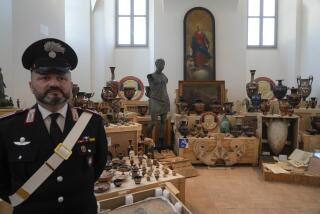Antiquities Stuck in Legal Limbo
- Share via
CHICAGO — For decades, scholars at the University of Chicago’s Oriental Institute have painstakingly pieced together ancient clay tablets they had on loan from the government of Iran -- deciphering the cuneiform writings and studying what these thousands of fragments revealed about the history of Persia.
But now, this treasure trove sits in the middle of a politically charged legal battle that has museum professionals worried about the willingness of other countries to loan artifacts to the U.S.
A federal court last month upheld a decision to seize and sell off the collection, in order to raise funds to compensate Americans injured in a terrorist attack in the Middle East. The reasoning, according to court documents, is that the Islamic Republic of Iran is a state sponsor of terrorism.
The lawsuit dates back to a 1997 attack in Israel, when suicide bombers attacked the Ben Yehuda mall in downtown Jerusalem. Five people were killed and more than 190 were injured. Hamas, the party that controls the current Palestinian government and has received some support from Iran, claimed responsibility for the bombing.
Some of the survivors were Americans, who filed suit in federal court in Chicago against Iran in 2001. They said that the country was responsible for their injuries because of its support of Hamas.
A federal judge in 2003 ruled in their favor and, when Iran didn’t appear in court to fight the claim, awarded the survivors more than $400 million.
That opened the way for the plaintiffs to go after Iran’s assets in America -- including the collection of ancient Persian tablets.
Patty Gerstenblith, a professor of cultural property law at DePaul University College of Law in Chicago, said this was believed to be the first case to link cultural artifacts on loan to terrorism litigation.
“The question now becomes, ‘How do you treat cultural artifacts? Are they to be seen like any other kind of property, like land?’ ” Gerstenblith said.
Attorneys for Iran, who appeared in federal court here Tuesday, are appealing the seizure. They claim they are protected by a legal principle known as sovereign immunity, which states that governments can’t be sued like regular citizens.
A hearing in the case is slated for Monday in federal court in Chicago.
The Department of Justice has tried to intervene, by filing court documents claiming that the country’s national interest would be better-served if the dispute were settled through diplomacy instead of legal action.
The University of Chicago and the Field Museum, a natural history museum in Chicago that also has a collection of ancient Persian artifacts from Iran, are defending the Islamic regime. Museum officials said they worried that turning over the on-loan artifacts could create a chilling effect, and were concerned that nations would curtail their willingness to share priceless objects -- and that American artifacts could be at risk of being seized while touring overseas.
The decision also has sparked outrage among Iranian citizens, who fear the thorny relations between Iran and the U.S. could lead to an important part of their heritage being lost forever.
The tablets and other artifacts, which date back to the Achaemenid period (550 BC to 330 BC), were excavated in the 1930s by a team of U.S. archeologists digging near the site of Persepolis (in southern Iran).
Over the years, researchers in Chicago and in Iran discovered that the tablets were records of administrative details, including “salary and wages of government employees and workers, child benefit to mothers with babies, [and] offerings to gods and temples,” said archeologist Shahrokh Razmjou.
Even the condition of the items offers a nod to the past: Some of them were broken when the army of Alexander the Great set fire to Persepolis in 330 BC, during the last of the wars between ancient Greeks and Persians.
Standing at a table in her windowless office in the basement of the Iran National Museum in Tehran, chief archeologist Zahra Jafar-Mohammadi carefully pulled out from a small wooden box a yellowish clay tablet, one that had been returned to Tehran from the Chicago museums. (University officials say that between 1948 and 2004, two-thirds of the collection was sent back.)
Most of the tablets are small enough to fit into the palm of a person’s hand. Many were broken, forcing scientists to sift through thousands of shards to piece the tablets back together.
She’s still waiting to see the estimated 5,000 tablets and 10,000 clay fragments that remain in Illinois.
“Auctioning off these pieces would be a catastrophe,” Jafar-Mohammadi said.
*
Staff writer Huffstutter reported from Chicago and special correspondent Naji from Tehran.
More to Read
Sign up for Essential California
The most important California stories and recommendations in your inbox every morning.
You may occasionally receive promotional content from the Los Angeles Times.










